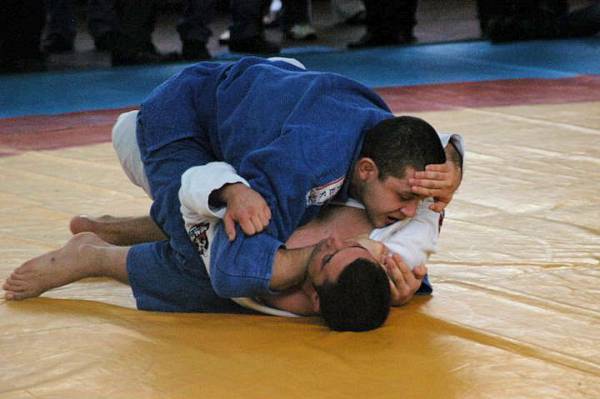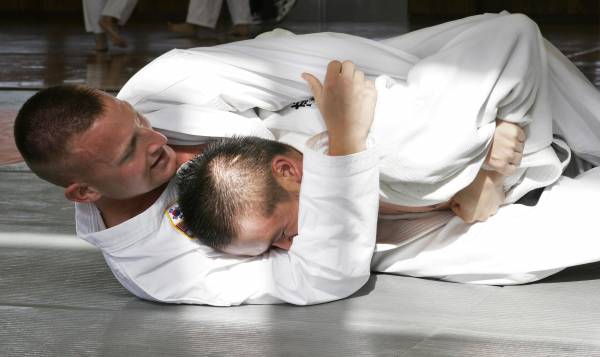The sport of MMA is a combination of boxing, Brazilian jiu jitsu, wrestling, and muay Thai. Every mixed martial arts fighter needs to have some experience in each of these disciplines in order to be successful.
Brazilian jiu jitsu itself is really no different. But in BJJ, we are not mixing different martial arts – we are mixing multiple energy systems.
BJJ is a complex sport that requires the body to tap into its aerobic and anaerobic energy systems.
Anaerobic and Aerobic Exercise
Most sports or types of exercise can be divided into two categories: aerobic and anaerobic. Aerobic exercise is any activity that can be maintained continuously for a long duration, such as marathon running and jump roping. Anaerobic exercise looks like things such as sprinting or weightlifting. During anaerobic exercise, glycogen is used as fuel, and the exercise is intense enough to trigger lactic acid fermentation.
“An athlete with good anaerobic capabilities is going to find himself struggling without the proper aerobic conditioning.”
BJJ is one of the rare sports that requires both the aerobic and anaerobic energy systems. As with our MMA analogy, knowing or practicing only one aspect of the sport is going to result in poor performance. For example, an MMA fighter who does not box is not going to make it far. The same holds true for our BJJ training. An athlete with good anaerobic capabilities is going to find himself struggling without the proper aerobic conditioning.
Aerobic Exercise in BJJ
Aerobic exercise is a low-intensity activity done for long periods of time. During this time, the body taps into the aerobic energy generating process. Aerobic activities are normally done at 60-65% of the athlete’s maximum heart rate. In order to meet the energy requirements, the body relies on oxygen via aerobic metabolism. The most common examples of aerobic activity are long-distance running and cycling.
In BJJ, the time period of a match can vary from five to ten minutes. It is impossible for someone to sprint for five minutes. During a match, there are periods of time when it feels like a sprint, but these periods are short and then the pace is slowed. When the pace slows you are back in aerobic territory, and you are going to suffer without the right conditioning.
Anaerobic Exercise in BJJ
Anaerobic exercise is a short, high-intensity activity where your body’s demand for oxygen exceeds the oxygen supply available. Therefore, anaerobic exercise is not dependent on oxygen. Some examples of anaerobic exercise are powerlifting, sprinting, and interval training.
In BJJ, anaerobic energy is important for quick, explosive movements like what you experience in a scramble. Scrambles are short and fast, and this requires the support of the anaerobic energy system.

Assessing Your Needs
In order to be successful on the mat, you must train both energy systems, and the first step to doing so is an assessment. This can be as simple as taking a look at your current training.
Is there one area of your program that you feel is missing? For example, if you are always doing long duration, low-intensity sessions, then you know you need to add in some higher-intensity training. The best place to start is with the area you are lacking the most.
“The goal of both your anaerobic and aerobic BJJ training should be to gain muscular endurance in the specific patterns you will use on the mat.”
It is also important to keep your training in context. Your number one priority is BJJ. You are not a marathon runner; therefore, an aerobic workout for you will not look the same as the one for a runner. The longest match for a black belt competing in the IBJJF is ten minutes, and the shortest match is five. So, make sure you train for the appropriate “distance.”
The same approach holds true for anaerobic training. BJJ athletes are not training for track and field events. You do not need to spend hours sprinting. How fast you can sprint means nothing when you step on the mat.
There is one best way to prepare the body for BJJ – match the movements of the sport to your off-the-mat training. The goal of both your anaerobic and aerobic BJJ training should be to gain muscular endurance in the specific patterns you will use on the mat.

2 BJJ Workouts for Specific Energy Systems
Note: The workouts below are supplemental. That is, if you have time to do them, they are a great addition to your regular BJJ training. But they should never replace your time spent in jiu jitsu class.
Aerobic BJJ Training Session
- Time per round: 5-10 minutes (start at 5 and work your way up to 10)
- Rest: Rest for the same time as your round. If you work for 5 minutes, then rest for 5. If your partner is also drilling, then you can feed for him or her and this time period turns into active rest.
- Pace: Slow
- Total session time: 30-40 minutes
Option 1:
Choose one technique and drill it at a slow pace for the allowed time of the round. An example is working the same pass for five minutes straight, over and over again. You can pick the same technique and perform it for multiple rounds or change the technique with each round.
Option 2:
Choose a series of techniques and do them in a row. For example, knee slide pass to the back. Then, have your partner escape the back. Repeat that series for the allowed time all reps are done in a controlled manor at pace that is sustainable for the allowed time.
Anaerobic BJJ Training Session
- Time: 10-30 seconds per technique. Start with 10 seconds, then rest 10 seconds after each set. Work your way up to 30 seconds.
- Rest: Match the rest interval to your work interval.
- Pace: Fast
- Total session time: 20-30 minutes
Option 1:
Pick one technique and do it as quickly as you can for the allowed time. For example, drill triangles from closed guard for 30 seconds. Shoot as many triangles as possible. Then, rest for 30 seconds and repeat the same drill or choose another.
Option 2:
Combine two techniques. For example, start in side control, go to knee on belly, your partner pushes your knee, and you go for the armbar.
You Need Both
Brazilian Jiu Jitsu is a complex sport that requires the body to tap into its aerobic and anaerobic energy systems. To be fully prepared for this, make sure you include both aerobic and anaerobic training in your program. This will help you to build a larger engine, allowing you to train for longer and at a higher intensity. Not to mention you’ll be more prepared come competition day.
You’ll Also Enjoy:
- Why Does BJJ Make Me So Tired?
- Strength Training for Judo: Grip Training and Cardio
- The Truth About Conditioning for Brazilian Jiu Jitsu
- New on Pulse Beat Fit Today
Photo 1 by parhessiastes via Wikimedia Commons.
Photo 2 by Teraforming via Wikimedia Commons.
Photo 3 by By Lance Cpl. Scott M. Biscuiti via Wikimedia Commons.






